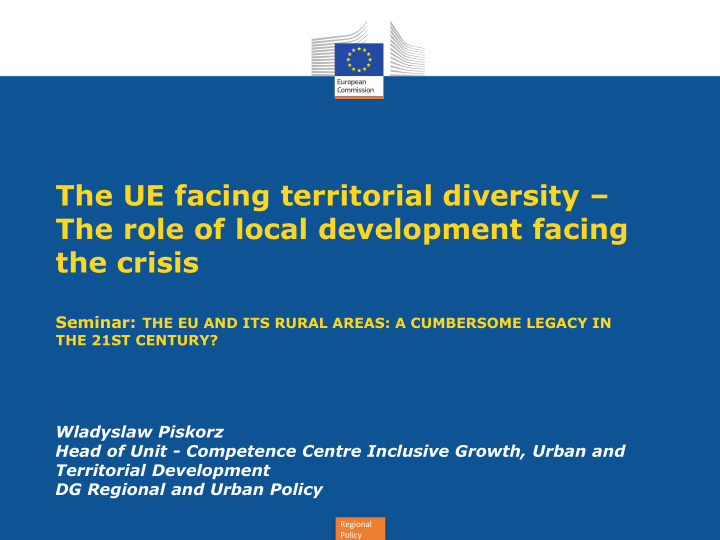



The UE facing territorial diversity – The role of local development facing the crisis Seminar: THE EU AND ITS RURAL AREAS: A CUMBERSOME LEGACY IN THE 21ST CENTURY? Wladyslaw Piskorz Head of Unit - Competence Centre Inclusive Growth, Urban and Territorial Development DG Regional and Urban Policy Regional Policy
Spatial planning not EU competence…BUT … agreement on principles & objectives at European level Territorial cohesion (EU Treaty objective) … harmonious, sustainable and polycentric development • Leipzig charter (Intergovernmental) • Inclusive and integrated sustainable urban development Toledo declaration (Intergovernmental) • Implementing the Leipzig charter in Europe 2020 context Territorial Agenda of the European Union 2020 – (Intergov.) • Balanced economic growth • Balanced territorial organisation • Polycentric urban structure • Good accessibility to services of general economic interest • Compact settlement structure with limited urban sprawl • High level of protection and quality of the environment Regional Policy
Territorial cohesion: ensuring harmonious, sustainable and polycentric development… …enabling citizens and enterprises • to make the most of the inherent features of different territories • to benefit from and contribute to European integration and the functioning of the Single Market • wherever they happen to live or operate Concentration: overcoming differences in density Connection: improving accessibility and reducing the economic significance of distance Cooperation: reducing the impact of international and inter-regional boundaries Different meanings in different territorial contexts Regional Policy
Integrated territorial approaches • Focus on specific functional territories, areas or places; • Builds on integrated strategies to reach area specific objectives in line with overall national and regional objectives; • Demands solid and shared knowledge of potential and challenges; • Empowers stakeholders close to the place or territory that are essential for its development Regional Policy
Thematic Concentration on Europe 2020 priorities dimension: Smart growth Sustainable growth Inclusive growth Research & Low-carbon Employment • • • Innovation Resource-efficiency Social inclusion • • ICT Risk-prevention Education • • • SME Transport • • Territorial Instruments dimension: Integrated strategies and actions Urban neighbourhoods Urban <=> rural C I Cities and towns linkages L T Functional urban areas, metropolitan regions L I Other functional economic or geographic areas D Rural areas Regional Policy
Community-Led Local Development: definition Article 28.2 of Common Provisions a) focused on specific sub-regional territories ; b) community-led , by local action groups composed of representatives of public and private local socio- economic interests , no majority partner c) Carried out through integrated and multi-sectoral area- based local development strategies; d) considering local needs and potential , include networking and (where relevant) cooperation. ERDF article 5 investment priority 9 (d): investments undertaken in the context of Community-led local development strategies Regional Policy
ITI & CLLD - inside the strategic framework Partnership Agreement • Overall priorities, territorial challenges & approaches EMFF EAFRD ESF ERDF CF Idem Idem • Idem • Fund • • Idem • specific investment priorities related to Europe 2020 thematic objectives Community-Led Local Development Integrated Territorial Investments Regional Policy
CLLD value added: capacity building and empowering the local population The potential added value of Leader approach is not solely in • the results and impacts of the physical outputs. The community involvement achieved through the bottom-up approach can also lead to less tangible impacts, such as "capacity-building" and "empowering the local population " (ECA special report on Leader 5/2010). Capacity building at local level as a key element of CLLD • approach. Promoting community ownership, finding local solutions to • local problems. 8 Regional Policy
Community-led local development under future cohesion policy Optional for ERDF, ESF and EMFF, obligatory under EAFRD Incentives: CLLD actions programmed under one thematic objective (TO9) for ERDF , ESF and EAFRD: Promoting Social Inclusion and Combating poverty – but allows funding strategies and projects with wider scope. For ERDF and ESF, an entire priority axis dedicated to CLLD benefits from 10% higher EU co-financing rate. Regional Policy
Why CLLD in all European Structural and Investment Funds? • Integrated territorial approach allowing more coherence and synergies between the ESI Funds • URBAN Community Initiatives have proven relevance in urban areas • Allows interventions in peri-urban • Supports urban-rural partnerships • No more white spots on the map • Regional Policy
Commission's role • CLLD guidance discussed with and available for Member States • CLLD examples were presented during the Open Days • A continued exchange of experience between Member States at the Territorial Cohesion and Urban Matters sub- committee • Development of more examples…. But the regulation is very flexible • Regional Policy
Thank you! wladyslaw.piskorz@ec.europa.eu ec.europa.eu/inforegio Future regional policy http://ec.europa.eu/regional_policy/index_en.cfm http://ec.europa.eu/regional_policy/what/future/proposals_2014_2020_en.cfm Common Guidance by the ESI Funds on CLLD : http://ec.europa.eu/regional_policy/what/future/pdf/preparation/clld_guidance_2013_04_29.pdf Regional Policy
Recommend
More recommend